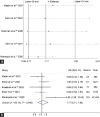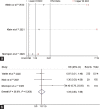Impacts of androgen deprivation therapy on the risks and outcomes of SARS-CoV-2 infection in patients with prostate cancer
- PMID: 35915542
- PMCID: PMC10226495
- DOI: 10.4103/aja202246
Impacts of androgen deprivation therapy on the risks and outcomes of SARS-CoV-2 infection in patients with prostate cancer
Abstract
Studies have investigated the effects of androgen deprivation therapy (ADT) use on the incidence and clinical outcomes of coronavirus disease 2019 (COVID-19); however, the results have been inconsistent. We searched the PubMed, Medline, Cochrane, Scopus, and Web of Science databases from inception to March 2022; 13 studies covering 84 003 prostate cancer (PCa) patients with or without ADT met the eligibility criteria and were included in the meta-analysis. We calculated the pooled risk ratios (RRs) with 95% confidence intervals (CIs) to explore the association between ADT use and the infection risk of severe acute respiratory syndrome coronavirus 2 (SARS-CoV-2) and severity of COVID-19. After synthesizing the evidence, the pooled RR in the SARS-CoV-2 positive group was equal to 1.17, and the SARS-CoV-2 positive risk in PCa patients using ADT was not significantly different from that in those not using ADT (P = 0.544). Moreover, no significant results concerning the beneficial effect of ADT on the rate of intensive care unit admission (RR = 1.04, P = 0.872) or death risk (RR = 1.23, P = 0.53) were found. However, PCa patients with a history of ADT use had a markedly higher COVID-19 hospitalization rate (RR = 1.31, P = 0.015) than those with no history of ADT use. These findings indicate that ADT use by PCa patients is associated with a high risk of hospitalization during infection with SARS-CoV-2. A large number of high quality studies are needed to confirm these results.
Keywords: androgen deprivation therapy; coronavirus disease 2019; meta-analysis; prostate cancer; severe acute respiratory syndrome coronavirus 2.
Conflict of interest statement
None
Figures





Similar articles
-
Relationship Between Androgen Deprivation Therapy for Prostate Cancer and Risk of SARS-CoV-2 Infection: A Systematic Review and Meta-Analysis.J Korean Med Sci. 2022 Aug 8;37(31):e237. doi: 10.3346/jkms.2022.37.e237. J Korean Med Sci. 2022. PMID: 35942555 Free PMC article.
-
Association between SARS-CoV-2 infection and disease severity among prostate cancer patients on androgen deprivation therapy: a systematic review and meta-analysis.World J Urol. 2022 Apr;40(4):907-914. doi: 10.1007/s00345-021-03810-6. Epub 2021 Sep 3. World J Urol. 2022. PMID: 34477955 Free PMC article.
-
Androgen deprivation therapy in men with prostate cancer is not associated with COVID-2019 infection.Prostate. 2023 May;83(6):555-562. doi: 10.1002/pros.24485. Epub 2023 Jan 19. Prostate. 2023. PMID: 36658755
-
Effects of Androgen Deprivation Therapy on COVID-19 in Patients with Prostate Cancer: A Systematic Review and Meta-Analysis.Urol J. 2021 Jul 24;18(6):577-584. doi: 10.22037/uj.v18i.6691. Urol J. 2021. PMID: 34302737
-
Influence of androgen deprivation therapy on the severity of COVID-19 in prostate cancer patients.Prostate. 2021 Dec;81(16):1349-1354. doi: 10.1002/pros.24232. Epub 2021 Sep 13. Prostate. 2021. PMID: 34517429 Free PMC article.
Cited by
-
Antiandrogens as Therapies for COVID-19: A Systematic Review.Cancers (Basel). 2024 Jan 10;16(2):298. doi: 10.3390/cancers16020298. Cancers (Basel). 2024. PMID: 38254788 Free PMC article. Review.
-
Collateral effects of the COVID-19 pandemic on endocrine treatments for breast and prostate cancer in the UK: a cohort study.Ther Adv Med Oncol. 2024 Jun 2;16:17588359241253115. doi: 10.1177/17588359241253115. eCollection 2024. Ther Adv Med Oncol. 2024. PMID: 38832300 Free PMC article.
References
-
- Al-Kuraishy HM, Hussien NR, Al-Naimi MS, Al-Buhadily AK, Al-Gareeb AI, et al. Is ivermectin-azithromycin combination the next step for COVID-19? Biomed Biotechnol Res J. 2020;4:101.
Publication types
MeSH terms
Substances
LinkOut - more resources
Full Text Sources
Medical
Miscellaneous

